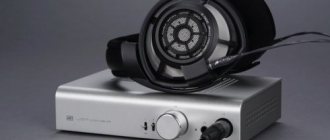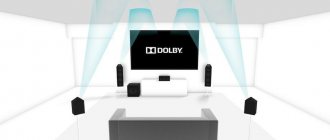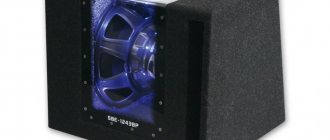When it comes to sound quality, opinions not only differ, but the discussion often leads to a dead end. As a rule, the reason for this is a different understanding of the concept of quality. In this article we will try to answer fundamental questions and give clear definitions, which can certainly help bring such discussions to a common denominator.
But first we need to give a clear definition of the concept of quality. The easiest way to do this is by establishing a number of requirements for certain characteristics and processes, and subsequently identifying the degree of their compliance in relation to the characteristics of the result obtained. This definition originates in a slightly different area, but all of the above is also true in relation to sound. For example, even at the development phase, establish the maximum permissible amount of harmonic distortion introduced into the audio signal due to one or another manipulation. Based on this, we can say that the closer the characteristics of the result are to predetermined requirements, the higher the quality. However, some manufacturers may abuse this definition to make their products look better than they actually are. So, purely hypothetically, by setting the bar low, in principle, you can theoretically improve quality, at least on paper. This trick is often used by manufacturers of HiFi equipment in the lower price segment, declaring that their speaker systems, for example, are capable of reproducing a frequency range from 20 Hz to 20 kHz, without mentioning that the attenuation of the signal amplitude at a frequency of 20 Hz is 20 dB and , to be honest, this figure has no right to appear in the specification.
First of all, before we start talking about sound quality, we should divide this concept into two separate categories, which, on the one hand, are closely interrelated, and on the other, describe different aspects, both technical and aesthetic, and are therefore often confused.
What is sound
Sound
- These are sound waves that are formed as a result of vibrations and changes in the atmosphere, as well as objects around us.
Even when talking, you hear your interlocutor because he influences the air. Also, when you play a musical instrument, whether you beat a drum or pluck a string, you produce vibrations of a certain frequency, which produces sound waves in the surrounding air.
Sound waves are ordered
and
chaotic
. When they are ordered and periodic (repeated after a certain period of time), we hear a certain frequency or pitch of sound.
That is, we can define frequency as the number of times an event occurs in a given period of time. Thus, when sound waves are chaotic, we perceive them as noise
.
But when the waves are ordered and repeat periodically, then we can measure them by the number of repeating cycles per second.
Sound quality
Describes the subjective judgment of what an individual listener heard and is therefore often based on individual preferences, biases and even prejudices. Moreover, even visual aspects can influence subjective perception and judgment of sound quality. When talking about sound quality, more vague terms are used, such as warmth, transparency, detail, density, brightness or dimness.
To determine the sound quality of an audio system, you first need to take into account the sound quality of the source, as if there was no audio system between the listener and the sound source. For example, the sound quality of an instrument consists of a combination of factors such as the melody of the composition, the virtuosity of the musician and, of course, the characteristic features of the instrument itself.
Audio sampling rate
The audio sampling rate is the number of signal level measurements per second. Hertz (Hz) or Hertz (Hz) is a scientific unit of measurement that determines the number of times an event occurs per second. This is the unit we will use!
Audio sampling rate
You've probably seen this abbreviation very often - Hz or Hz. For example, in equalizer plugins. Their units of measurement are hertz and kilohertz (that is, 1000 Hz).
Typically, a person hears sound waves from 20 Hz to 20,000 Hz (or 20 kHz). Anything less than 20 Hz is infrasound
.
Anything above 20 kHz is ultrasound
.
Let me open the equalizer plugin and show you what it looks like. You are probably familiar with these numbers.
Sound frequencies
With an equalizer, you can cut or boost certain frequencies within the human audible range.
A small example!
Here I have a recording of a sound wave that was generated at a frequency of 1000 Hz (or 1 kHz). If we zoom in and look at its shape, we will see that it is regular and repeating (periodic).
Repetitive (periodic) sound wave
In one second, a thousand repeating cycles occur here. For comparison, let's look at a sound wave, which we perceive as noise.
Disordered sound
There is no specific repeating frequency here. There is also no specific tone or pitch. The sound wave is not ordered. If we look at the shape of this wave, we can see that there is nothing repeating or periodic about it.
Let's move on to the richer part of the wave. We zoom in and see that it is not constant.
Disordered wave when scaling
Due to the lack of cyclicity, we are not able to hear any specific frequency in this wave. Therefore we perceive it as noise.
Related links
Information from the sponsor
Gazgolder.ru: autonomous liquefied gas supply systems, autonomous gasification. A generally recognized leader in the industry, who stood at the origins of its foundation in Russia. You are provided with a wide range of gasification services, incl. warranty and service. The company works with both individuals and legal entities. You can find out the cost of autonomous gasification on the company’s website (link above).
For example, when I launch an MP3 file in Aimp, the recording bitrate is written in the playback window, for example 320kbps. Is this a good quality or a bad one? In general, how can you understand the quality from this figure, the more the better? Or is it an inverse relationship?
Enlighten me. I would like to listen to music in good quality)
LIKE THIS and LIKE THIS and listen to a lot of high-quality music on the appropriate equipment!
If you have good Hi-Fi equipment, or high-quality on-ear headphones, then check out the best studio sound of the most famous song from my Savage collection • Only You is a rip from the vinyl record of the 1984 album “Tonight”, the quality and warmth of the sound is close It's not even worth it with a CD! ! At first the sound may seem a little unusual, but if you are not hard of hearing, you will immediately notice a huge difference not in favor of the CD! !
Lethal sound level
I would like to mention a little about the lethal sound level for humans. It starts at 180 dB
and higher.
It is worth saying right away that according to regulatory standards, a safe noise level is considered to be no more than 55 dB (decibels) during the day and 40 dB at night. Even with prolonged exposure to hearing, this level will not cause harm.
| Sound volume levels | ||
| (dB) | Definition | Source |
| 0 | It's not loud at all | |
| 5 | Almost inaudible | |
| 10 | Almost inaudible | Quiet rustling of leaves |
| 15 | Barely audible | rustling leaves |
| 20 — 25 | Barely audible | Whisper of a person at a distance of 1 meter |
| 30 | Quiet | The ticking of a wall clock ( permissible maximum according to standards for residential premises at night from 23 to 7 o'clock ) |
| 35 | Quite audible | Muffled conversation |
| 40 | Quite audible | Normal speech ( the norm for residential premises during the day from 7 to 23 hours ) |
| 45 | Quite audible | Talk |
| 50 | Clearly audible | Typewriter |
| 55 | Clearly audible | Conversation ( European norm for class A office premises ) |
| 60 | Noisy | (the norm for offices ) |
| 65 | Noisy | Loud conversation (1m) |
| 70 | Noisy | Loud conversations (1m) |
| 75 | Noisy | Scream and laughter (1m) |
| 80 | Very noisy | Scream, motorcycle with muffler |
| 85 | Very noisy | Loud scream, motorcycle with muffler |
| 90 | Very noisy | Loud screams, freight railway car (7m) |
| 95 | Very noisy | Subway car (7 meters outside or inside the car) |
| 100 | Extremely noisy | Orchestra, thunder ( according to European standards, this is the maximum permissible sound pressure for headphones ) |
| 105 | Extremely noisy | On old planes |
| 110 | Extremely noisy | Helicopter |
| 115 | Extremely noisy | Sandblasting machine (1m) |
| 120-125 | Almost unbearable | Jackhammer |
| 130 | Pain threshold | Airplane at the start |
| 135 — 140 | Contusion | Jet plane taking off |
| 145 | Contusion | Rocket launch |
| 150 — 155 | Concussion, injuries | |
| 160 | Shock, trauma | Shock wave from a supersonic aircraft |
| 165+ | Rupture of eardrums and lungs | |
| 180+ | Death | |
Acoustics: three roads, three ways
What is a good speaker system is the most confusing question. The choice of acoustics depends on the individual characteristics of a person’s hearing, the parameters of the room in which the system will be placed, and financial capabilities. In this three-variable system, finding a middle ground is very difficult. Therefore, we will consider three fundamental options for solving the problem.
Solution one. Budget. You can equip your home audio with speaker systems. These small systems can be placed on a bookshelf. They are convenient for a small room. Due to its small size, it is also an inexpensive option. A significant disadvantage of this solution is that “shelf” acoustics will not produce normal bass sound.
Solution two. Luxurious. If the dimensions of the room and financial capabilities allow, then you can buy floor-standing acoustics. This system, due to its size, can contain a large diameter woofer. This means there is a chance to enjoy good bass.
Solution three. "Golden" compromise. This solution is suitable for large and small rooms and is affordable. It consists of purchasing a subwoofer and satellites. The subwoofer is responsible for high-quality bass reproduction. Stellites reproduce high frequencies.
When choosing acoustics, you should not follow any advice. You need to rely only on your own hearing. You also need to be prepared for the fact that the sound of the acoustics in the store and in your apartment will be different.
Speed of sound in km per hour and meters per second
The speed of sound is the speed at which waves propagate in a medium. Below I give a table of propagation speeds in various environments.
| 0 ºС | m/s | km/h |
| Air | 331 | 1191.6 |
| Hydrogen | 1284 | 4622.4 |
| Nitrogen | 334 | 1202.4 |
| Ammonia | 415 | 1494.0 |
| Acetylene | 327 | 1177.2 |
| Helium | 965 | 3474.0 |
| Iron | 5950 | 21420.0 |
| Gold | 3240 | 11664.0 |
| Oxygen | 316 | 1137.6 |
| Lithium | 6000 | 21600.0 |
| Methane | 430 | 1548.0 |
| Carbon monoxide | 338 | 1216.8 |
| Neon | 435 | 1566.0 |
| Mercury | 1383 | 4978.0 |
| Glass | 4800 | 17280.0 |
| Carbon dioxide | 259 | 932.4 |
| Chlorine | 206 | 741.6 |
The speed of sound in air is much less than in solid media. And the speed of sound in water is much higher than in air. It is 1430 m/s. As a result, propagation is faster and audibility is much further.
Good nutrition is the key to comfortable sound
Finally, our home complex for high-quality music playback in digital format is assembled. Now all that remains is a mere trifle. Good equipment requires high-quality power supply. If the most expensive “brand” amplifiers, DACs, and players are powered from a common network, then there can be no talk of any high-quality sound. Voltage contaminated with interference will kill all efforts to select and purchase high-quality units for the audio center.
Organize power supply for each unit with a separate cable. The cables must be connected directly to the distribution panel at the entrance to the home. Connection sockets must provide a high degree of plug fixation. It is wise to use a surge protector; it will make the power supply, and therefore the sound, cleaner.
Pitch and note
Height
is a musical term that means almost the same thing as frequency. The exception is that it does not have a unit of measurement. Instead of defining sound by the number of cycles per second in the range of 20 - 20,000 Hz, we designate certain frequency values in Latin letters.
Musical instruments produce regular, periodic sound waves that we call tones or notes.
That is, in other words, the note
is a kind of snapshot of a periodic sound wave of a certain frequency. The pitch of this note tells us how high or low the note sounds. In this case, lower notes have longer wavelengths. And the tall ones are shorter.
Let's look at a 1 kHz sound wave. Now I'll zoom in and you'll see the distance between the loops.
Sound wave at 1 kHz
Now let's look at a 500 Hz wave. Here the frequency is 2 times less and the distance between cycles is greater.
Sound wave at 500 Hz
Now let's take a wave of 80 Hz. It will be even wider here and the height will be much lower.
Sound at 80 Hz
We see the relationship between the pitch of a sound and its waveform.
Each musical note is based on one fundamental frequency (fundamental tone). But in addition to tone, music also consists of additional resonant frequencies or overtones.
Let me show you another example!
Below is a wave at 440 Hz. This is the standard in the world of music for tuning instruments. It corresponds to the note A.
Pure sound wave at 440 Hz
We hear only the fundamental tone (pure sound wave). If we zoom in, we will see that it is periodic.
Now let's look at a wave of the same frequency, but played on a piano.
Intermittent piano sound
Look, it is also periodic. But it has small additions and nuances. All of them together give us an idea of how a piano sounds. But in addition to this, overtones also determine the fact that some notes will have a greater affinity for a given note than others.
For example, you can play the same note, but an octave higher. It will sound completely different. However, it will be related to the previous note. That is, it is the same note, only played an octave higher.
This relationship between two notes in different octaves is due to the presence of overtones. They are constantly present and determine how closely or distantly certain notes are related to each other.
Now I will show you using the music editor. Here we see how the note A is written.
The higher a note is on the staff, the higher its pitch. The lower a note is, the lower the pitch of its sound.
In addition to the traditional representation of notes on a stave, in modern music editors you can find another system for recording and editing notes. Most often it is a piano grid or table.
On the left we see a piano keyboard. And on the right, corresponding to each note, are rectangles.
In principle, such a system is no different from the classical one above. It's just that the way the pitches of notes are represented is implemented differently. Likewise, when we say 440 Hz or A, we are having the same pitch or frequency of sound.
Audio quality
The concept of audio refers to all objects connected in one way or another and participating in the process of transmitting, processing and storing signals, whether in analog or digital form, representing the original acoustic signal. An example of this could be the sound source itself, as well as patch cables, mixers, equalizers, amplifiers, processors and speaker systems. Audio quality is determined by the degree of fidelity to the representation of the original audio signal, without taking into account the intentional nature of the manipulation (see below). The terms used in this case may be, for example, impedance, dynamic range, level, frequency range, letency, signal-to-noise ratio and similar characteristics.
Properties and sound quality
Sound properties
are its physical features that can be measured. This includes the frequency of vibrations, their duration and amplitude. The composition of vibrations also applies. That is, a combination of simple vibrations into complex ones.
But the reflection of physical properties in our sensations (what we feel) is called sound quality
. This includes the pitch and duration of the sound. As well as volume and timbre.
The pitch of the sound depends on the vibration frequency. The more frequent the vibrations, the higher the sound. The rarer the vibrations, the lower the sound.
The duration depends on the duration of the oscillations.
The volume depends on the amplitude of the vibrations. For example, after hitting a guitar string, you can see that it will begin to vibrate in different directions. The wider these vibrations, the louder the sound. The width of this range is called the amplitude of oscillations
.
If we hit the string hard, the amplitude will be large. Accordingly, we will hear a loud sound. If we lightly touch the string with our finger, the amplitude will be small. In this case, the sound will be quiet.
Timbre
- This is the overtone coloring of sound. It allows us to distinguish sounds of the same pitch, but performed by different instruments or voices.
Player – searching for a win-win solution
Choosing a player must begin with an understanding of the form in which the home audio library will be formed. You can buy CDs the old fashioned way or switch to purchasing your favorite music online. The latter option has two significant advantages. It is compact and environmentally friendly:
- The question of space in the apartment for storing CDs does not arise.
- No need to throw faulty disks in the trash.
Have you decided how to buy music? Great! If you buy CDs, you need a CD player. If you prefer online shopping, look for a player on a hard drive or flash memory. Undecided? Great! Look for a universal player. On this you can listen to both discs and files purchased online.
Naturally, you can turn it into a player and a personal computer. But this option is convenient when the computer is truly personal. The prospect of competition for space at the keyboard and possible conflicts will significantly reduce the pleasure of listening to music in good quality.
When choosing a player, pay special attention to the available connectors. The more connector options, the easier it will be to select other elements of the music center.
Audio coding
Audio encoding is the process of converting air vibrations into electrical current vibrations and then sampling the analog signal. That is, we need such encoding for further work with sound on the computer.
And since we cannot work with an analog signal on a PC, in this case we must convert it to digital. So we can, for example, use special computer programs for creating sound to work with the signal itself.
To convert the signal, special analog-to-digital converters (ADCs) are used. In a computer these are usually sound cards.
DAC! And the digital turns... into an analog signal
The player has read a digital sequence from a CD or file. Now comes the most mathematical moment of digital audio reproduction. The digital signal is converted to analog. This math happens in a DAC, or digital-to-analog converter.
The DAC can be built into the player or implemented as a separate unit. If you want to get high quality sound, you need to opt for the second option. The built-in converter is usually inferior in quality to a separate one. The external DAC has its own power supply, the built-in one is powered from a common source with the player. When using an external DAC, its operation is almost unaffected by interference from the player and amplifier.
External DAC according to circuit design solutions is implemented in 4 main versions:
- Pulse width modulator;
- Resampling scheme;
- Weighing type;
- Ladder type, or R-2R chain circuit.
With such a wealth of choice to achieve high quality sound, the R-2R option appears to have no alternative. Due to a special circuit implemented using precision resistances, the ladder-type DAC can achieve very high conversion accuracy.
When choosing an external digital-to-analog converter, you should pay attention to two main characteristics:
- Bit depth. It’s good if the selected model has 24 bits.
- Maximum sampling rate. Very good value 96 kHz, excellent 192 kHz.
Sources of sound waves
We say that sound is wave-like movements or vibrations. Anyone who has seen or felt what happens when a sound is born will immediately agree with this. So, for example, if you pull a thread tightly and then quickly hit it, you can see how it vibrates. And at the same time hear a small musical sound. The same thing will be observed in a sounding piano string or in a bell. And we can feel these vibrations if we touch them.
Sources of sound waves. Scheme of a stretched string
We also know that when you hit glass, it makes a sound that stops if you touch it with your finger to stop its vibrations. All these phenomena serve as proof that certain vibrations produce sound. Every time a bell, glass or string vibrates, the air receives light blows from them. It produces a series of waves that reach our ear, which is why we hear sound.
It is not difficult to prove that air conducts sound waves. For this purpose, the following experiment is carried out: an electric bell is placed under the glass cover of the air pump and made to ring continuously. Then they begin to pump out the air.
Sound waves. Call experience
When the amount of air under the hood decreases, we see the bell just as well as before, because the light spreads when there is no air. But the sound becomes quieter and finally stops. The bell continues to oscillate, but since there is no more air around it, it cannot produce those waves. which we call sound. If air begins to re-enter under the hood, the sound is restored. This simple experiment shows us not only that air serves as a conductor of sound, but also that the strength of sound depends largely on the state of the air.
When we have the opportunity to compare the speed of light with the speed of sound, we find a huge difference between them. But we see fire and smoke when firing from a distant cannon several seconds before the sound of its shot. Light travels so quickly that even a significant distance at which an active weapon is located from us, it travels in just a thousandth of a second; whereas sound travels much more slowly, and the speed of its propagation with such an experiment is very easy to calculate.
How to Listen: New software that will teach you how to listen
Research has shown that sound quality is determined by the following categories of attributes: timbral, spatial, dynamic or associated nonlinear distortion. These four attributes are divided into additional sub-attributes that describe more specific acoustic characteristics of the attribute. For example, Bright-Dim or Full-Thin are timbral sub-attributes that refer to relative pre-emphasis and high- and low-frequency equalization, respectively. Spatial sub-attributes deal with the position and width of acoustic patterns, as well as the sense of spatiality and ambience. Distortion sub-attributes include noise, hum, acoustic clipping, and distortion inherent to the audio devices under test.
Spectral – Spectral Spatial – Spatial Distortion – Distortion Dynamics – Dynamics Band ID – Band ID Spectral Plot – Spectral graph Spatial Mapping – Spatial distribution Attribute Rating – Attributes Bright-Dull – Bright-dim Full-Thin – Full-thin Coloration – Clipping coloring – Noise-Hum Codec Distortion Left-Right Bias Front-Rear Bias Image Stability Listener Envelopment Image Width Reverberation Dynamic Compression - Dynamic compression Preference Rating - Seventeen lessons, each focusing on one or more sound quality attributes: spectrum (timbre), spatiality, distortion and dynamics.
The goal of How to Listen is to teach listeners to evaluate sound quality based on these four attributes and their sub-attributes. During listening, one or more attributes are inserted into the recording. The listener's task is to recognize and report changes using appropriate terms and quantities. An analogue of this program can be called the Wine Aroma Wheel, where wine tasters are trained to distinguish the richness of certain aromas present in wine.
To facilitate the learning process, Harman engineers Sean Hess and Eric Hu developed the How to Listen computer program. The program works on both Mac and PC, and plays stereo and multi-channel audio files. The app's built-in DSP allows you to manage audio quality attributes in real time based on listener responses and performance.
MAC owners and Win XP users with good sound cards have nothing to worry about, but for Vista and Windows 7 users the task becomes more complicated, because How to Listen does not have ASIO support or Wasapi output. Accordingly, all sound will be subject to additional distortion from the Windows mixer.
The latest version of the program has five types of training tasks that focus on one or more attributes: 1. Band Identification 2. Spectral Graph 3. Spatial Distribution 4. Attribute Test 5. Preference Test Band Identification teaches students to identify spectral distortions in based on their frequency, level and quality factor, using peak/trough combinations and high/low pass filters. In each lesson, the student compares the unadjusted version of the track (FLAT) and the version corrected using one of the filters displayed on the screen. The listener must select the filter (Filter 1 or 2) that they believe was used to correct the track.
Screenshot of the “Lane Identification” task in the “How to Listen” program from Harman. The listener compares the uncorrected "Flat" and the adjusted (EQ) version and must select the equalization filter that was applied to that track.
The difficulty of each task is automatically increased or decreased depending on the student's performance. The listener immediately receives a comment on each answer. If the answer is incorrect, he can again choose any of the proposed answer options.
In the Spectral Graph lesson, the listener is asked to compare several music programs that have been adjusted in different ways. The listener must select the equalization curve that best suits the proposed sound quality. This lesson teaches students to behave like a human harmonic analyzer. After completing the entire training course, the student will be able to independently draw a graph of the frequency response of his audio system, based on its sound.
The Spatial Distribution lesson requires the listener to graphically indicate on a two-dimensional map where a sound appears in the listening space. In the Attributes lesson, the learner must place two or more sounds in the correct order on a given attribute scale based on the frequency of the attribute (e.g., bright-dim). In the Preferences lesson, the listener must use his or her discretion to classify music by sound quality with one or more attributes modified. Listener performance is calculated based on a secondary statistical test that determines the objectivity and reliability of the listener's preference ratings. All tasks generally teach the listener to critically evaluate any sound quality they may encounter while listening to recorded and reproduced sound.
Conclusion on the sound quality tutorial How to Listen
Assessing sound quality remains a very difficult task in the audio industry.
Better awareness, better understanding, and the ability to distinguish sounds based on their quality may be possible if there is a method that teaches listeners to evaluate the quality of the sound being reproduced and to report what they heard using unambiguous and understandable terminology. How to Listen is a training course that will help you achieve these goals. Listeners are taught to identify and evaluate acoustic changes through various perceptions of sound quality, which include spectral, spatial, dynamic characteristics and distortion of recorded music. Performance measures based on the objectivity, accuracy, and reliability of the listener's responses determine whether the listener meets the criterion of being a "trained" listener. The question of whether a listener has excellent hearing or not is no longer a matter of guesswork and debate, because the correct answer will be given by How to Listen. You can download the free tutorial here https://harmanhowtolisten.blogspot.com/ Author:
14.10.2012
Found a typo in the text?
Select and press
Ctrl+Enter
. This does not require registration. Thank you.
Propagation of sound waves
Let's take several billiard balls and place them in a straight line on the billiard table so that they touch each other. Then take another ball and roll it so that it hits the ball lying at the end of the row. Then each of the balls in the row will alternately compress and exert pressure on the next one, as a result of which the ball located at the other end of the row will bounce off it.
Propagation of sound waves. Experience with billiard balls
Each ball of the row here alternately contracts and expands. The same thing happens in the air when sound passes through it. We can imagine that the wave is forced to move by particles of air hitting each other as they move back and forth, just like these billiard balls.
Help Microsoft identify your audio driver
The computer operating system offers assistance in determining the required sound driver. You need to point the cursor to the “My Computer” folder, right-click (RMB), then “Properties”, then “Hardware”. You can make it simpler: right-click the “My Computer” folder and go to the device manager section.
A list will open in the device manager, select the sound card (there is no driver, there is an exclamation mark next to it). Select the line, at the top there is the “Update driver” option, then the “Search for drivers” item, when everything happens with a positive result, the “Install” window will be offered.
Perhaps the recommended automatic search will not produce results, then we will use another method.
Note-octave system
In general, the range of sounds potentially audible to the human ear covers almost 11 octaves. Because our course is devoted to musical literacy, we are only interested in musical sounds, i.e. approximately 9 octaves. To make it easier to remember octaves and the corresponding pitch ranges, we recommend going from top to bottom, i.e. from the upper range of sounds to the lower. For ease of memorization, we indicate the pitch in hertz for each octave in the binary system.
Octaves (names) and ranges:
- Fifth octave – 4096-8192 Hz.
- The fourth octave is 2048-4096 Hz.
- Third octave – 1024-2048 Hz.
- The second octave is 512-1024 Hz.
- The first octave is 256-512 Hz.
- Small octave – 128-256.
- Large octave – 64-128 Hz.
- Contractave – 32-64 Hz.
- Subcontractave – 16-31 Hz.
It makes no sense to consider other octaves in the context of musical sounds. Thus, the highest note for men is “F sharp” of the 5th octave (5989 Hz), and this record was set by Amirhossein Molai on July 31, 2022 in the city of Tehran (Iran) [Guinness World Records, 2019]. Singer Dimash from Kazakhstan reaches the note “D” in the 5th octave (4698 Hz). But the human ear cannot perceive sounds below 16 Hz. You can study the complete table of notes corresponding to frequencies and octaves in the following picture:
The 1st note of the first octave is highlighted in purple, i.e. the “C” note, and the green one is the “A” note of the first octave. It is to her, i.e. at a frequency of 440 Hz, all tuners for measuring pitch are preset by default.
Notes in an octave: notation options
Today, different methods are used to indicate that a note (pitch) belongs to different octaves. The easiest way is to write down the names of the notes as they are: “do”, “re”, “mi”, “fa”, “sol”, “a”, “si”.
The second option is the so-called “Helmholtz notation”. This method involves designating notes in Latin letters, and belonging to the octave - in numbers. Let's start with the notes.
Sheet music according to Helmholtz:
- C = "before".
- D = "re".
- E = "mi".
- F = "fa".
- G = "salt".
- A = "la".
- B = "si".
It is also important to note that the note "B" may sometimes be represented by the letter H rather than the letter B. The letter H is traditional in classical music, while the letter B is considered a more modern variation. You'll find both variations in our course, so remember that both B and H stand for the B note.
Now to the octaves. Notes in the first to fifth octaves are written in small Latin letters and designated by numbers from 1 to 5. Notes in the small octave are written in small Latin letters without numbers. Remember the association: small octave - small letters. Major octave notes are written in capital Latin letters. Remember: big octave means big letters. Contra-octave and sub-contra-octave notes are written in capital letters and numbers 1 and 2, respectively.
Notes in Helmholtz octaves:
- The fifth octave is c5-b5.
- The fourth octave is c4-b4.
- The third octave is c3-b3.
- The second octave is c2-b2.
- The first octave is c1-b1.
- Small octave – cb.
- Major octave – NE.
- Contractave – C1-B1.
- Subcontractive – C2-B2.
If anyone is wondering why the first note of the octave is not designated by the first letter of the Latin alphabet, let us tell you that once upon a time the counting began with the note “A”, which was assigned the designation A. However, then they decided to start the octave counting with the note “C” , which has already been assigned the designation C. In order to avoid confusion in musical notations, we decided to keep the letter designations of the notes as they are.
You can find out more about Helmholtz’s notation and his other ideas in his work, available in Russian under the title “The Doctrine of Auditory Sensations as a Physiological Basis for the Theory of Music” [G. Helmholtz, 2013].
And finally, the scientific notation, which was developed by the Acoustical Society of America in 1939 and which is also still relevant today. Notes are indicated by capital Latin letters, and octave membership is indicated by numbers from 0 to 8.
Scientific notation:
- The fifth octave is C8-B8.
- The fourth octave is C7-B7.
- The third octave is C6-B6.
- The second octave is C5-B5.
- The first octave is C4-B4.
- Small octave – C3-B3.
- Major octave – C2-B2.
- Contractave – C1-B1.
- Subcontractive – C0-B0.
Please note that the numbers do not coincide with the names of the octaves from the first to the fifth. This circumstance often misleads even manufacturers of specialized programs for musicians. Therefore, when in doubt, always check the sound and pitch of the note with a tuner. To do this, download the Pano Tuner mobile application and allow it access to the microphone.
It remains to add that the scientific notation system was first published in the July issue of The Journal of the Acoustical Society of America (the journal of the Acoustical Society of America).
Now let’s summarize all currently accepted note notation systems for each octave. To do this, we will once again duplicate the already familiar picture with the piano keyboard and the designations of scale steps (notes), but with the recommendation to pay attention to the digital and letter designations:
And finally, in order to fully understand the basic information of music theory, we should understand the types of tones and semitones.











